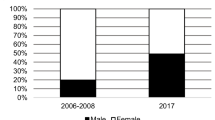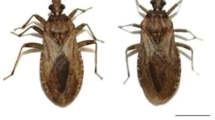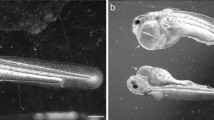Abstract
In the fresh-water planarians Dugesia benazzii and D. lugubris, diploid amphimictic and polyploid pseudogamic biotypes occur, each of them with a peculiar chromosome cycle. In crosses between diploid biotype (acting as female) and polyploid ones, various degrees may be observed from amphimictic diploid to polyploid pseudogamic offspring. All cytological mechanisms that characterise the cycles of natural biotypes and of hybrids are inherited independently and only rarely can they be found together in a harmonic complex in such a way as to reconstruct the natural polyploid pseudogamic biotypes. The author analyses the genetical mechanisms which, in nature, may have led to the formation of these polyploid biotypes.
Similar content being viewed by others
Literature
Barigozzi, C.: Il legame genetico fra i biotipi partenogenetici di Artemia salina. Arch. Zool. ital. 22, 33–73 (1936); - Différenciation des génotypes et distribution géographique d'Artemia salina Leach: données et problèmes. Année biol. 33, 241–250 (1957).
Battaglia, E.: Apomixis. Rec. Advanc. Embryol. of Angiosperms, p. 221–264. Ranchi: Univ. Delhi Catholic Press 1963.
Bělař, K.: Über den Chromosomenzyklus von parthenogenetischen Erdnematoden. Biol. Zbl. 43, 513–518 (1923).
Benazzi, M.: Un decennio di ricerche cariologiche sulle planarie. Ric. sci. C.N.R.A 24, No 5, 1012–1015 (1954); - Ulteriori ricerche sui poliploidi sperimentali della planaria Dugesia lugubris (O. Schmidt). Caryologia (Firenze) 12, 414–438 (1960); - Genetics of reproductive mechanisms and chromosome behavior in some fresh-water triclads. In: The Lower Metazoa (ed. by E. G. Dougherty), p. 405–422. Berkeley: California University Press 1963.
— e G. Benazzi Lentati: Corredo cromosomico e meccanismi della ovogenesie della fecondazione in ibridi fra biotipi diploidi e poliploidi di Planarie. Ric. Sci., Suppl. (Convegni di Genetica) 29, 3–10 (1959).
Benazzi Lentati, G.: Angigonia in Tricladi diploidi e comportamento dello spermio in incroei fra biotipi diploidi anfigonici e poliploidi pseudogamici. Arch. Zool. ital. 41, 113–128 (1956); - Processi maturativi ed evoluzione dello spermio in ovociti sinaptici ed asinaptici di Planarie. Atti Soc. Tosc. Sci. nat., Ser. B 46, 60–80 (1959); - Congiderazioni sul determinismo dei cicli cromosomici in ibridi di Planarie. Caryologia (Firenze) 14, 271–277 (1961); - Due modalità di sviluppo dello stesso tipo di uova in ibridi interraziali di Planarie. Acta Embryol. Morph. exp. (Palermo) 5, 145–160 (1962); - Ancora sulle modalità di sviluppo degli ovociti di ibridi interraziali di Planarie. Monit. zool. ital. 70–71, 326–334 (1962–1963); - Sulla regolazione dei processi maturativi di ovociti di Planarie attivati da spermi normali ed irradiati. Boll. Zool. 31, 963–972 (1964).
—, e V. Bertini: Sul determinismo della “Asinapsi femminile” in ibridi di Dugesia benazzii. Atti Soc. Tosc. Sci. nat., Ser. B 48, 83–112 (1961).
—, e G. Magagnini: Sulla manifestazione della “Asinapsi femminile” in ibridi interraziali di Dugesia lugubris. Atti Ass. Genet, ital., Pavia 8, 150–160 (1963); - Ancora sulla ereditarietà della asinapsi femminile nelle Planarie. Rend. Acad. naz Lincei, Ser. VIII, 37, 511–518 (1964).
—, e I. Puccinelli: Ulteriori ricerche sugli ibridi fra biotipo triploide e biotipo tetraploide di Dugesia benazzii: Produzione di individui triplo-esaploidi. Caryologia (Firenze) 12, 110–131 (1959).
Bergerard, J.: Parthenogenesis in the Phasmidae. Endeavour 21, 137–143 (1962).
Clausen, J.: Partial apomixis as an equilibrium system in evolution. Caryologia (Pisa) 1, 469–479 (1954).
Cognetti, G.: La partenogenesi negli afidi. Boll. Zool. 29, 129–147 (1962).
Darlington, C. D.: Evolution of genetic systems. Edinburgh: Oliver & Boyd 1958.
Gustaffson, A.: Apomixis in higher plants. P. I0 The mechanism of apomixis. Lunds Univ. Årsskr., N.F. Avd. 2, 42, 1–66 (1947); - P. II0 The causal aspect of apomixis. Lunds Univ. Årsskr., N.F. Avd. 2, 43, 71–178 (1947).
Haskins, C. P., E. F. Haskins, and R. E. Hewitt: Pseudogamy as an evolutionary factor in the poeciliid fish Mollienisia formosa. Evolution (Lancaster, Pa.) 14, 473–483 (1960).
Hertwig, P.: Abweichende Form der Parthenogenese bei einer Mutation von Rhabditis pellio. Arch. mikr. Anat. 94, 303–337 (1920).
Krüger, Z.: Fortpflanzung und Keimzellenbildung von Rhabditis aberrans n. sp. Z. Zool. 105, 87–124 (1913).
Müntzing, A.: The balance between sexual and apomictic reproduction in some hybrids of Potentilla. Hereditas (Lund) 44, 145–160 (1958).
Narbel-Hofstetter, M.: L'origine de la parthénogénèse. Bull. Soc. vaudoise Sci. nat. 67, 357–368 (1961).
Nigon, V.: Le detérminisme du sexe et la pseudogamie chez un nématode parthénogenétique, Rhabditis monohystera Bütschli. Bull. biol. France et Belg. 81, 33–37 (1947); - Modalités de la reproduction et déterminisme du sexe chez quelques Nématodes libres. Ann. Sci. nat. Zool. 11, 1–128 (1949).
Peacock, A. D., and U. Weidmann: Recent work on the cytology of animal parthenogenesis. Przegl. zool. 5, 5–27 (1961).
Puccinelli, I.: Cinetica dei cromosomi nella maturazione degli ovociti asinaptici della Planaria Dugesia lugubris. Rend.Acad. naz. Lincei, Ser. VIII, 36, 224–229 (1964).
Seiler, J.: Resultate aus der Kreuzung parthenogenetischer und zweigeschlechtlicher Schmetterlinge. Arch. Klaus-Stift. Vererb.-Forsch. 17, 513–528 (1942);- Über den Ursprung der Parthenogenese und Polyploidie bei Schmetterlingen. Arch. Klaus.-Stift. Vererb.-Forsch. 18, 691–699 (1943); - Untersuchungen über die Entstehung der Parthenogenese bei Solenobia triquetrella F. R. I. Mitt. Die Zytologie der bisexuellen S. triquetrella, ihr Verhalten und ihr Sexualverhältnis. Chromosoma (Berl.) 10, 73–114 (1959); - III. Mitt. Die geographische Verbreitung der drei Rassen von Solenobia triquetrella. Bemerkungen über die Entstehung der Parthenogenese. Z. Vererbungsl. 92, 261–316 (1961); - VI. Mitt. Biologische und zytologische Beobachtungen zum Übergang von der diploiden zur tetraploiden Parthenogenese. Chromosoma (Berl.) 15, 503–539 (1964).
Stalker, H. D.: Parthenogenesis in Drosophila. Genetics 89, 4–34 (1954).
Stefani, R.: La Telitochia. Boll. Zool. 31, 119–143 (1964).
Suomalainen, E.: Parthenogenesis in animals. Advanc. Genet. 3, 193–253 (1950); - On polyploidy in animals. Proc. Finnish Acad. Sci. 1–15 (1958); - Significance of parthenogenesis in the evolution of insects. Ann. Rev. Entomol. 7, 349–366 (1962).
Swanson, C. P.: Cytology and cytogenetics. London: Prentice-Hall 1957.
Vandel, A.: La parthénogenèse. Paris: Doin 1931.
White, M. J. D.: Animal cytology and evolution. Cambridge: Cambridge University Press 1954.
Author information
Authors and Affiliations
Additional information
Dedicated to Professor J. Seiler on the occasion of his 80th birthday.
Rights and permissions
About this article
Cite this article
Lentati, G.B. Amphimixis and pseudogamy in fresh-water triclads: Experimental reconstitution of polyploid pseudogamic biotypes. Chromosoma 20, 1–14 (1966). https://doi.org/10.1007/BF00331894
Received:
Issue Date:
DOI: https://doi.org/10.1007/BF00331894




